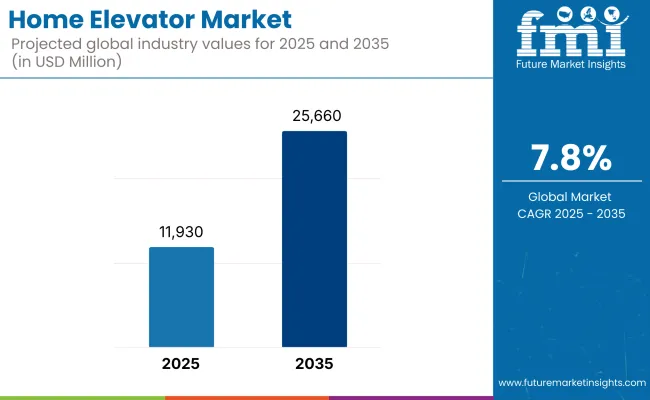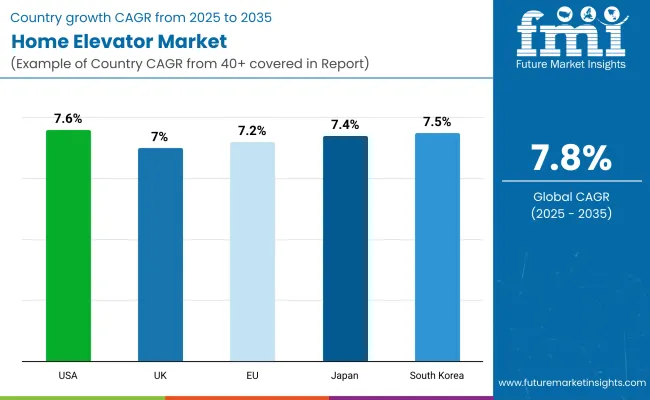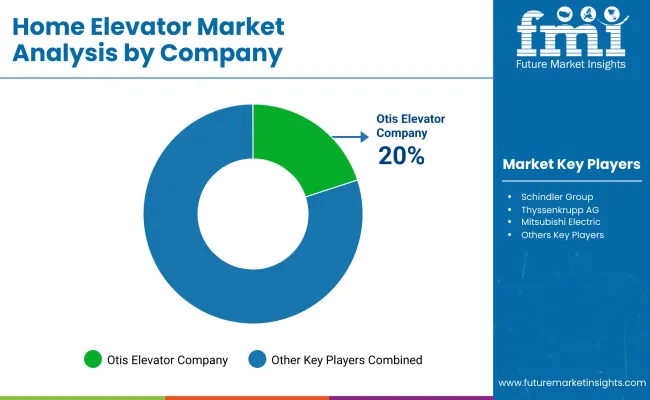The home elevator market is expected to experience substantial growth between 2025 and 2035, driven by rising urbanization, increasing demand for mobility solutions among the elderly, and advancements in home automation technologies.
The market was valued at USD 11,930 million in 2025 and is projected to reach USD 25,660 million by 2035, reflecting a compound annual growth rate (CAGR) of 7.8% over the forecast period.

Several factors contribute to the expansion of the home elevator market. The growing aging population, particularly in developed nations, has led to increased demand for residential elevators as a solution for enhanced mobility and accessibility.
Additionally, the trend toward luxury housing and smart homes is fueling the adoption of advanced home elevator systems with enhanced safety, automation, and energy-efficient features. The market is also witnessing significant investments in research and development to introduce compact and space-saving designs, making home elevators more suitable for a wider range of residential settings.
Despite the favourable growth outlook, the market faces certain challenges, including high installation costs and maintenance expenses, which may deter middle-income consumers.
Additionally, regulatory compliance and stringent safety standards add to the complexity of market expansion. However, innovations in cost-effective manufacturing, increased government incentives for accessibility solutions, and technological advancements such as pneumatic and gearless elevators are expected to drive market penetration.
The home elevator market is expected to grow steadily across the world, backed by increasing adoption of smart and accessible housing solutions. With manufacturers innovating to meet demand for energy-efficient and space-saving designs, demand from a variety of residential segments is expected to remain strong for a decade.
North America accounts for a substantial portion of the home elevator market, supported by growing accessibility needs for the older population and increasing home renovations. The USA and Canada hold the top rank aided by high disposable incomes and better tendency for luxury home modification.
Additionally, technological progress, along with IoT-enabled controls, energy-efficient designs, and smart elevators, is pushing the market growth, mentioned the report. But installation and high maintenance costs remain challenges. In counter to this, market participants emphasize on cost-effective solutions and provide financing options to make home elevators more affordable.
Countries such as Germany, France, UK and Italy, is driving a high demand for home elevators in Europe region. Major factors influencing market growth include the aging population and government initiatives encouraging independent living solutions.
This results in increased adoption of eco-friendly elevator systems which use less energy and have lesser structural modification. But new installations can be constrained by strict building regulations and zoning laws. To meet this demand, manufacturers are able to design small and retrofit table elevator models that conform to regional building codes.
The home elevator market is growing rapidly in the Asia-Pacific, driven by factors such as rapid urbanization, rising disposable incomes, and the popularity of multi-story residential structures. Due to the growing real estate development and improving living standards, developing nations like China, India, Japan, and South Korea are seeing a huge demand for home elevators.
Affordable elevator solutions and government incentives for elderly-friendly housing are also facilitating market adoption. But they face challenges in terms of high import duties and a shortage of skilled installation professionals. In order to combat these, manufacturers are strengthening their plants and offering training programs to enhance the quality of service.
High Installation and Maintenance Costs
The home elevator market faces a major challenge primarily related to the expensive installation costs and maintenance costs. Home elevators necessitate structural changes, which might raise the cost of construction and renovation, limiting their availability for a wider consumer segment.
Annual servicing and necessary repairs for safety, efficiency, and repairs are also uniforms, and so the total cost of ownership of fossil-fuel vehicles is also high. Such economic roadblocks can close market access, particularly in wealthy regions.
Growing Demand for Aging-in-Place Solutions
Some of the major factors that allow the demand for home elevators to grow are the growing aging population and the increasing demand for aging in-place solutions. Our customers are senior citizens and individuals with mobility impairments who are looking for comfortable home modifications that will improve their independence and safety.
Technological development in compact and cost-effective elevator systems like shaft less lifts and pneumatic elevators is enabling homeowners to install elevators inside their residence. For your organization that invests in cooler, simple to-install models with smart network functionality, this trend can set you up to be that market frontrunner.
In the period between 2020 and 2024, the overall home elevator market was experience counts of systematic growth thanks to factors such as the rising disposable household income, urbanization and changing customer focus on luxury home under the macro economy. But it was costly, difficult to comply with regulations, and not widely known in developing areas. Manufacturers leveraged advancements in compact designs, space saving foot prints, and safety standards to increase demand from this market.
In the 2025 to 2035 preview, the market is poised to gain from technology breakthroughs in Artificial Intelligence (AI) based predictive maintenance, energy-efficient elevator system and seamless integration with smart home automation. Rising government initiatives for barrier-free residential accommodation and enhanced penetration of prefabricated modular lift will support the market growth.
Market Shifts: A Comparative Analysis 2020 to 2024 vs. 2025 to 2035
| Market Shift | 2020 to 2024 Trends |
|---|---|
| Regulatory Landscape | Stricter building codes and safety regulations |
| Technological Advancements | Development of compact, space-saving models |
| Industry Adoption | Growth in urban luxury home renovations |
| Supply Chain and Sourcing | Dependence on traditional manufacturing |
| Market Competition | Dominance of high-end brands and traditional players |
| Market Growth Drivers | Rising disposable income and real estate development |
| Sustainability and Energy Efficiency | Introduction of low-energy consumption models |
| Consumer Preferences | Preference for compact, luxury-oriented elevators |
| Market Shift | 2025 to 2035 Projections |
|---|---|
| Regulatory Landscape | Streamlined approvals for home mobility solutions |
| Technological Advancements | Integration of AI-driven predictive maintenance and smart automation |
| Industry Adoption | Widespread adoption in aging-in-place and assisted living homes |
| Supply Chain and Sourcing | Rise of modular and prefabricated elevator solutions |
| Market Competition | Entry of smart home companies and cost-effective solutions |
| Market Growth Drivers | Aging population and accessibility-focused infrastructure |
| Sustainability and Energy Efficiency | Widespread adoption of eco-friendly and regenerative drive elevators |
| Consumer Preferences | Demand for customizable, smart, and cost-efficient solutions |

Leading the charge in the home elevator market is the United States, driven by an increased focus on accessibility solutions, an aging population, and rising luxury home renovations. The key factors driving the market growth include the presence of key manufacturers, advanced smart elevator technologies, and increasing investments in home automation. Also, a growing number of multigenerational households is driving demand for residential mobility solutions.
| Country | CAGR (2025 to 2035) |
|---|---|
| United States | 7.6% |
There is steady growth in the UK home elevator market, representing an expanding population of older homeowners looking for ways to live independently. A growing number of compact and energy-efficient elevator technologies paired with government incentives for home retrofitting are also fuelling market expansion. All this growth is also being contributed by the rise of premium housing projects.
| Country | CAGR (2025 to 2035) |
|---|---|
| United Kingdom | 7.0% |
Demand for home elevators is increasing in the European Union due to an aging population, a growing investment in real estate, and regulatory support for home accessibility solutions. The market is dominated by Germany, France, and Italy, reflecting a growing adoption of advanced, space-saving elevator technologies. Cellular and energy-efficient smart-connected elevator solutions are on the rise.
| Country | CAGR (2025 to 2035) |
|---|---|
| European Union | 7.2% |
Japan’s home elevator market is growing because of a rapidly aging population, a rising desire for barrier-free housing, and more disposable income. Technological advancements in energy-efficient and earthquake-resistant elevators continue to enhance this demand. The market is also buoyed by the country’s emphasis on premium housing projects.
| Country | CAGR (2025 to 2035) |
|---|---|
| Japan | 7.4% |
The other booming market in the world for home elevators is South Korea. This demand is burgeoning because of increasing urbanisation, an increase in the number of luxury homes and the ageing population. The market growth is further augmenting in light of the government initiatives promoting accessibility solutions and smart home automation. Demand for customized and compact elevators in residences is growing.
| Country | CAGR (2025 to 2035) |
|---|---|
| South Korea | 7.5% |
Home elevator market is expected to grow due to demand for better home accessibility rising with aging population and luxury home modifications. With growing urbanization and rising disposable incomes, an increasing number of homeowners are opting for elevators for improved accessibility and better value of their property. These are some of the factors that drive the expansion of the market, in addition to the innovative solutions such as energy-efficient, compact, and smart home-integrated elevator solutions.
The trend in residential buildings toward the integration of machine room-less (MRL) and hydraulic elevators is growing, while introduction of better safety features, touchless controls, and AI-based diagnostics are establishing new trends in the industry.
Machine room-less (MRL) elevators have the largest share among type segments because of their compact design, reduced installation time and costs, and enhanced energy efficiency.
MRL elevators, on the other hand, are machine-room-less elevators, which require no dedicated machine room, making them the perfect choice if you're limited on space in your home. The elevators are gearless traction, which means lower maintenance costs and smoother, quieter operation. Homeowners choose MRL elevators for their contemporary look, improved safety features, and eco-friendly operation.
Installed cabinet does not require a separate top or bottom room; instead, the shaft can be constructed to fit like a cabinet in your house, making this hydraulic home elevator ideal for larger houses demanding higher weight capacities. These elevators have smooth movement and high durability so they are suitable for multi-story homes. However, increased energy consumption and the requirement for an oil-based hydraulic system have restricted their uptake when compared to MRL equivalents.
However, machine room elevators require a space for the motor and control system, which is less efficient than MRL systems. These are most often seen installed in bespoke luxury homes, where living space is not at a premium.
Shaft-less home lifts and pneumatic vacuum elevators form part of this segment, which is rapidly gaining ground due to ease of retrofitting and space efficient features. Pneumatic elevators, which use air-pressure differentials, are very well-suited for small homes and for limited-space applications.
By application, passenger elevators dominate the share and are largely driven by the increasing demand for mobility solutions with the growing elderly and disabled population.
Home elevators for passengers are extensively utilized by single-family and multi-family residential to ensure mobility and ease of transportation. Demand for luxury residential elevators equipped with smart control systems, voice recognition, and remote monitoring features are increasing in both high-end and custom-built homes. Moreover, the market is also driven by government initiatives and regulations that encourage enhancement of accessibility in residential buildings.
Freight elevators are used in homes that need industrial lifting solutions, such as the transportation of heavy furniture, groceries or heavy equipment up or down between floors. These elevators are not as common in standard residential applications but have become popular for large estates, villas, and high-end homes with large storage or service areas.
With the ongoing advancements in compact designs, touchless technology, and AI-based diagnostics, the home elevator industry is set to experience continuous sales expansion. Residential elevators will become an integral component of many new homes and renovations, as they can be easily integrated with energy-efficient motors and smart home connectivity, as well as offer high-speed lifting mechanisms.
The home elevator market is gaining traction due to the rising need for residential mobility solutions, the needs of the aging population, and installations in luxury homes. For new-age homes, home elevators make for a great option as they offer improved accessibility, increased property value, and convenience.
As consumer needs evolve, manufacturers are responding with energy-efficient design, space-saving solutions and smart automation features. Window hardware saw tepid increase in revenue and unit sales, but entry door hardware had more excitement with an increase in numbers.
Market Share Analysis by Company
| Company Name | Estimated Market Share (%) |
|---|---|
| Otis Elevator Company | 20-24% |
| Schindler Group | 15-19% |
| Thyssenkrupp AG | 12-16% |
| Mitsubishi Electric | 10-14% |
| Other Companies (Combined) | 30-40% |
| Company Name | Key Offerings/Activities |
|---|---|
| Otis Elevator Company | Specializes in high-performance home elevators with advanced safety and energy-saving features. |
| Schindler Group | Develops customized residential elevator solutions with smart technology integration. |
| Thyssenkrupp AG | Offers compact and space-efficient home elevators designed for modern and retrofit installations. |
| Mitsubishi Electric | Provides premium home elevators with smooth operation, quiet performance, and high durability. |
Key Company Insights

Otis Elevator Company(20-24%)
Otis is the Nation’s home elevator market leader with its innovative high-efficient residential elevators. Preserving energy, optimizing space, and smart home integration are key themes within the company and have only bolstered its position within the market.
Schindler Group(15-19%)
Schindler Group is a global manufacturer of mobility solutions for residential environments, and they offer customized home elevators with automation and AI based controlling solutions. Its focus on contemporary visuals and fluid performance fosters user adoption.
Thyssenkrupp AG(12-16%)
Thyssenkrupp AG produces space-saving residential elevators with minimal construction and ease of use. The company is investing in sustainable technology and modular designs for elevators.
Mitsubishi Electric(10-14%)
Mitsubishi Electric specializes in quiet high-efficiency residential elevators. It has been the go-to pick amongst luxury homeowners for its commitment to safety, energy efficiency, and long-lasting durability.
Other Notable Contributors(30-40% Combined)
Several manufacturers are working towards automation, innovative and smart, sleeker, and portable home elevator solutions for better accessibility. Key players include:
The overall market size for the home elevator market was USD 11,930 million in 2025.
The home elevator market is expected to reach USD 25,660 million in 2035.
The demand for home elevators is expected to rise due to rising urbanization, increasing demand for mobility solutions among the elderly, and advancements in home automation technologies.
The top five countries driving the development of the home elevator market are the USA, Germany, China, Japan, and the UK.
Hydraulic home elevators and machine room-less (MRL) home elevators are expected to command a significant share over the assessment period.






Full Research Suite comprises of:
Market outlook & trends analysis
Interviews & case studies
Strategic recommendations
Vendor profiles & capabilities analysis
5-year forecasts
8 regions and 60+ country-level data splits
Market segment data splits
12 months of continuous data updates
DELIVERED AS:
PDF EXCEL ONLINE
Home Sleep Screening Device Market Size and Share Forecast Outlook 2025 to 2035
Home Healthcare Software Industry Analysis in North America Size and Share Forecast Outlook 2025 to 2035
Home Decor Market Size and Share Forecast Outlook 2025 to 2035
Home Automation Sensors Market Size and Share Forecast Outlook 2025 to 2035
Home Energy Management Systems Market Size and Share Forecast Outlook 2025 to 2035
Home Dialysis Systems Market Size and Share Forecast Outlook 2025 to 2035
Home Standby Gensets Market Size and Share Forecast Outlook 2025 to 2035
Home Scales Market Size and Share Forecast Outlook 2025 to 2035
Home Gym Equipment Market Size and Share Forecast Outlook 2025 to 2035
Home Brewing Systems Market Size and Share Forecast Outlook 2025 to 2035
Home Brew Boiler Market Size and Share Forecast Outlook 2025 to 2035
Homeland Security Market Size and Share Forecast Outlook 2025 to 2035
Home Wi-Fi Security Solutions Market Size and Share Forecast Outlook 2025 to 2035
Home Security Drone Market Size and Share Forecast Outlook 2025 to 2035
Home Infusion Therapy Devices Market Analysis - Size, Share, and Forecast Outlook 2025 to 2035
Home Healthcare Market Analysis - Size, Share, and Forecast Outlook 2025 to 2035
Homeopathic Products Market Analysis - Size, Share, & Forecast Outlook 2025 to 2035
Home Care Services Market Size, Growth, and Forecast 2025 to 2035
Home Sleep Apnea Testing Market Analysis - Size, Share, and Forecast Outlook 2025 to 2035
Home Office Spending Market by Solution Deployment, Application & Region Forecast till 2025 to 2035

Thank you!
You will receive an email from our Business Development Manager. Please be sure to check your SPAM/JUNK folder too.
Chat With
MaRIA